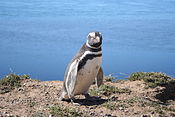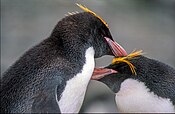[Common name]: Magellanic penguin
[Binomial name]: Spheniscus magellanicus
[Population]: 2 600 000
[Status]: NT
[Trend]:
[Notes]: Only mature individuals were included in the count (1.3 million pairs).
[Image]:
(Species by global population)[Common name]: Galapagos penguin
[Binomial name]: Spheniscus mendiculus
[Population]: 1800
[Status]: EN
[Trend]:
[Notes]:
[Image]:
(Species by global population)[Common name]: African penguin
[Binomial name]: Spheniscus demersus
[Population]: 75 000 – 80 000
[Status]: EN
[Trend]:
[Notes]: 5000 breeding pairs in Namibia & 21 000 in South Africa.
[Image]:
(Species by global population)[Common name]: Macaroni penguin
[Binomial name]: Eudyptes chrysolophus
[Population]: 18 000 000
[Status]: VU
[Trend]:
[Notes]: Only mature individuals were included in the count (9 million pairs); main population centres at Île des Pingouins, Heard and McDonald (1 million pairs each), Kerguelen (1.8 million pairs), & South Georgia (2.5 million pairs).
[Image]:
(Species by global population)[Common name]: Fiordland penguin
[Binomial name]: Eudyptes pachyrhynchus
[Population]: 5000 – 6000
[Status]: VU
[Trend]:
[Notes]: Only mature individuals were included in the count.
[Image]:
(Species by global population)[Common name]: Humboldt penguin
[Binomial name]: Spheniscus humboldti
[Population]: 3300 – 12 000
[Status]: VU
[Trend]:
[Notes]:
[Image]:
(Species by global population)
New Random Display Display All Items(16)









